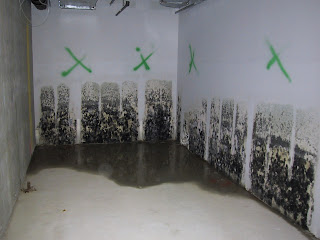 |
| Asbestos Inspector Initial Course |
Another popular method for collecting debris and dust samples is the American Society of Testing and Materials (ASTM) standard "D5755 - Microvaccum Sampling and Indirect Analysis of Dust by Transmission Electron Microscopy for Asbestos Structure Number Concentrations" The D5755 method requires vacuuming a known surface area (100 squared centimeters is mentioned in the standard but it could be larger or smaller). The vacuuming is done with a standard 25 or 37-millimeter air sampling cassette (the air sampling cassette should have a mixed cellulose ester (MCE) or polycarbonate (PC) filter membrane with a pore size less than or equal to 0.8 micron) and an air sampling pump. A plastic tube should be attached to the inlet orifice to act as a nozzle and should be cut at a 45 degree angle. The air sampling pump should be calibrated to run at 2 liters per minute. The D5755 method incorporates a method of analysis for the sample, however, in NYS that method cannot be used. According to the NYSDOH ELAP Frequently Asked Questions (FAQ) number 8, "all bulk samples collected must be analyzed by ELAP
approved methodology at an ELAP accredited laboratory. ASTM method D5755 ....... are not certified as
ELAP approved methods of analysis." The method of analysis that shall be used, especially if you want transmission electron microscope analysis, is NYSDOH ELAP method 198.4.
 |
| SKC Catalog Photo |
The D6480 method also incorporates a method of analysis for the sample, however, again in NYS that method cannot be used. According to the NYSDOH ELAP Frequently Asked Questions (FAQ) number 8, "all bulk samples collected must be analyzed by ELAP approved methodology at an ELAP accredited laboratory. ASTM method......and D6480 are not certified as ELAP approved methods of analysis." The method of analysis that shall be used is NYSDOH ELAP method 198.4.
The interesting part about this is, NYS ELAP approved laboratories should be advising asbestos inspectors they cannot use the ASTM methods of analysis. However, we've heard of several times when this has not occurred. According to the above information, an inspector should be getting results for the samples collected in percent by weight (%), which they can then use to compare with the Environmental Protection Agency's (EPA's) definition that an asbestos containing material contains greater than 1% of asbestos by weight. If they use the ASTM methods they will get results of structures per square centimeter. There is no government standard to compare these results to and be able to give a determination is the material asbestos containing or not. However, that has not prevented individuals from determining that areas are contaminated, or that debris or dust is ACM. This has cost owners thousands and millions of dollars to cleanup areas based on this analysis. It is even more interesting to note that ASTM in the "Significance and Use" section states:
- This test method does not describe procedures or techniques required for the evaluation of the safety or habitability of buildings with asbestos-containing materials, or compliance with federal, state, or local regulations or statutes.....
- At present, a single direct relationship between asbestos sampled from a surface and potential human exposure does not exist.....



























